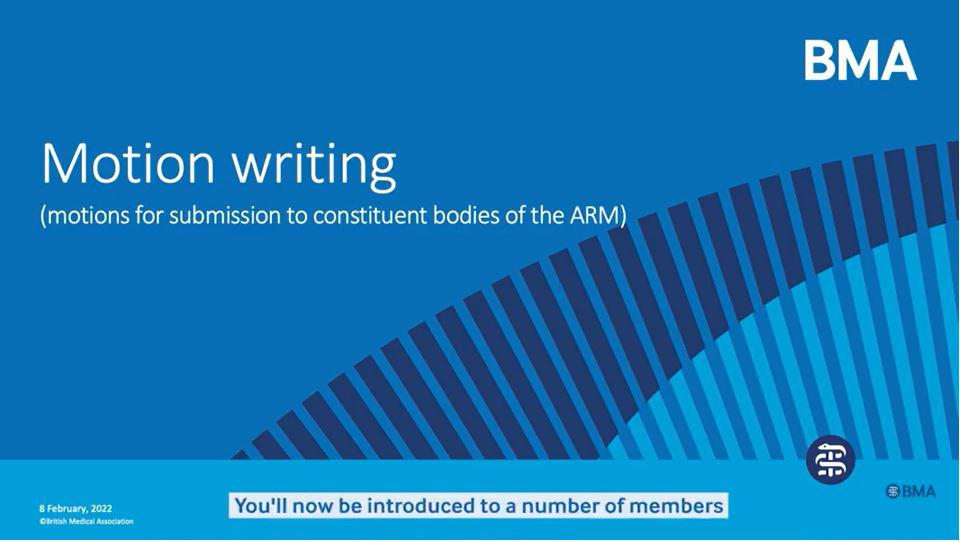The RB (Representative body), which consists of delegates from all BMA divisions and branches of practice, regional and national councils, meets each year at ARM to establish and develop BMA policy.
When a motion is passed at ARM, it becomes a resolution and is handed to the appropriate body for implementation and it ultimately becomes BMA policy.
Policy can also be developed through the representative conferences organised by the branches of practice. In matters where the branches of practice have delegated authority, this can be the final statement of policy on a subject.
Resolutions from annual representative meetings and the branch of practice conferences can be found on the policy database.
Top tips for writing a good motion

Your motion is more likely to be chosen if it comes with a call for action that the Association or branch of practice can take forward.
The video above gives comprehensive motion writing advice – it was created for ARM, but the information on good motion writing is also applicable for branch of practice conferences.
You can also read this blog for an example of how writing a motion for your branch of practice conference can turn your idea into national change.
When writing your motion, make sure it is:
- topical, accurate and concise
- comprehensible and logical
- likely to prompt good debate in a subject area on which it is desirable for the BMA to develop or change policy.
Motions should be clear statements and:
- start with the words "That this conference..." or, for ARM, “That this meeting...”
- cover the essential problem which needs to be solved (for example: “That this conference welcomes, regrets, deplores, denounces...”)
- cover the essential principle which underlies the solution (for example using words like reaffirm, recognise, declare)
- cover the essential proposal at the heart of the motion (for example: “That this meeting affirms, believes, recommends, urges...”)
Further aspects to consider
- The equality implications of the proposals in the motion, making sure that the motion does not have any inadvertent consequences (see below)
- The implications of the proposals for patients and the public (see below), particularly in terms of access to and the quality of health services
- The implications of the proposals for colleagues in other branches of practice.
- The impact and relevance for members in the devolved nations. Specify whether your motion applies to the UK, or to specific nations. Ensure you use appropriate terminology, as it may differ in each nation for: pay and contractual issues, governmental positions, NHS policy, system regulation, and education.
- Choose issues which are topical and new and not a repeat of existing policy. Check the policy database before submitting any motion.
- Include a proposal for action as this is far more useful in shaping policy and therefore makes a better motion.
- Use sections if you have several clear calls for action. As each section could be voted on separately this allows for motions which may contain a controversial element.
- Ensure that any subsections of a motion only deal with one point of principle and don't reference other subsections as they may be divided by the agenda committee. Each subsection must flow from the opening stem of the motion and be understandable without reference to the other subsections as the meeting may vote against one or more of the other subsections.
- Be concise and clear - write in plain English, explain any abbreviations and try not to go above 150 words. Try to keep the number of subsections to a minimum. Agenda committees will usually prefer no more than four.
- Ask for help if you're struggling - the agenda committee is there to assist you, so send through your ideas, drafts and questions - it's what they are there for.
- Be original - conferences need exciting, topical debates. Even if your motion fails it can still offer the conference a valuable perspective and an interesting debate.
- Write long opening paragraphs explaining the issue – save that for your speech proposing the motion. Avoid being repetitive, vague or didactic.
- Include quotations or actual sums of money both of which run the danger of being inaccurate or out of date and thus invalidating the motion. Again, these points can be covered in a speech.
- Submit motions which are already policy. Check the policy database first, or check with the agenda committee.
- Be afraid to submit a motion. They are key to us developing and shaping BMA policy into the future.
Equality considerations and evaluating the potential for discrimination for your proposed motion
Meaningful consideration must be given to how to both avoid creating discriminatory policy outcomes and to ensuring that the process of policy development does not involve negative or discriminatory practices.
When drafting the text for you proposed motion work through the following questions:
1. What are the intended consequences of this motion?
2. Does it breach or potentially breach, or offend established codes, standards, and legislation?
Including but not limited to:
- The BMA Code of Conduct incorporated the BMA’s values and behaviour principles.
- The Equality Act 2010 and other equalities and human rights legislation
- European Convention on Human Rights
- Employment Law
- Criminal law e.g. hate crime
- GMC standards for doctors e.g. Good Medical Practice (updated 2024)
Members can propose motions that challenge any of these standards. But there should be consideration of the potential for unlawful discrimination.
3. How might the implementation of the proposed motion impact negatively on individuals or groups with protected characteristics?
4. Could the proposed motion contribute to inequality, or disadvantage or discriminate against any individuals or groups with protected characteristics?
5. Will the activity of communication about this motion have a negative impact on a group of individuals?
6. Could the motion give rise to a reasonable perception that the motion is discriminatory even if it may not ultimately be discriminatory?
The protected characteristics are age, gender reassignment, being pregnant or on maternity leave, disability, race (including colour, nationality, ethnic or national origin); religion or belief, sex and sexual orientation. Case law has also determined that the following characteristics are also covered, caste, ethical veganism, non-binary and gender fluidity. Discrimination law is covered in the Human Rights Act 1998 and the Equality Act 2010 in England, Wales and Scotland with similar legislation in Northern Ireland (with the addition of political opinion as a protected characteristic).
Read more about the BMA and EDI in the BMA corporate equality, diversity and inclusion strategy 2022-25.
If you have any questions about equality considerations, please do get in touch with the Corporate EDI team [email protected].
Have you explored any patient considerations for your proposed motion:
- Have you considered the impact your proposed motion will have on patients accessing and receiving care?
- Have you considered if your proposal could impact negatively or disadvantage some groups of patients and if so, does your proposal contain actions to mitigate against this?
If you have any questions about the impact your motion will have on patients please get in touch with the BMA Patient Liaison Group (PLG) by emailing [email protected]
A sample motion
Below is an example of a previous motion, to give you an idea of the language and construction to use when writing your motion.
"That this meeting, recognising the challenges facing the provision of healthcare in rural, coastal and remote areas across the UK, therefore:-
i) considers that there is an overdue need for healthcare strategy for these areas in all four nations;
ii) emphasises that joined up action needs to be speeded up across relevant government departments;
iii) asks the BMA to highlight both the problems and solutions, and to lobby for national strategies and actions."
or
"That this conference is extremely concerned at the introduction of post-CCT fellowship posts and demands that these:
i) have defined training objectives that genuinely cannot be provided within CCT
ii) be created only to meet a proven and unmet need for consultants with particular sub-specialist skills
iii) be without service commitment
iv) not continue beyond 2010"
How to submit a motion
Motions may only be submitted by constituent bodies of the ARM. These are listed below.
- Divisions
- Regional councils
- National councils
- Armed forces committee
- Occupational Health committee
- Junior members forum
- Branch of practice and other conferences
Submitting motions to BMA conferences
Please be aware that motion deadlines may occur approximately two to three months prior to conferences taking place.
Motions must be submitted in advance by Medical staff and regional consultants committees.
Members can submit motions via the motion submission form available on the conference webpage.
Motions for the medical academics conference are submitted by MASC and its subcommittees or any representative to the conference by advance email.
Each UK medical school, MSC subcommittees, Regional Services Liaison Group, MSC (including co-optees) and devolved committees can submit motions via designated representatives.
Motions by anyone attending the conference can be submitted to the PHMC secretariat. If you cannot attend but wish to submit a motion, it is encouraged to ask a colleague to submit a motion in their name.
Motions can be submitted via regional and national SASCs to the SASC Agenda Committee.
Motions can be submitted via the LMCs (Local medical committees) and their conference representatives.
Members can submit motions via the designated retired members conference representatives.
Motions may only be submitted by honorary secretaries of BMA divisions and regional councils.
Contact the motion advisory service
The motion advisory service provides:
- advice
- facts and figures or information on existing policy
- helps you submit your motion correctly for consideration.
Please include your name, membership number, branch of practice and nation when contacting us, so we can respond to your enquiry as soon as possible.
Contact the motion advisory service via [email protected].
Submitting motions to ARM 2026
The ARM 2026 will be held from 22 to 24 June 2026. Further details to follow.
Deadline
The deadline for constituent bodies to submit motions is 9am on 1 April 2026.

